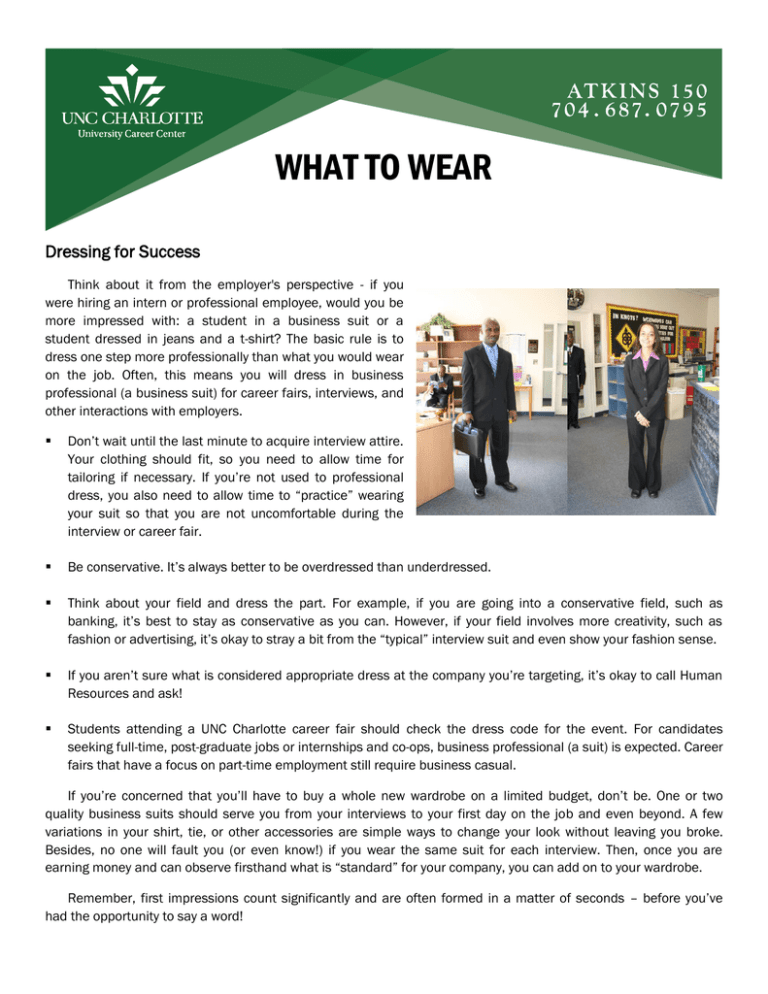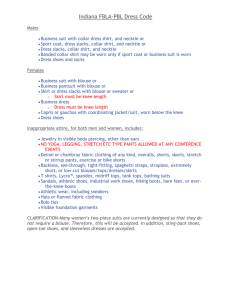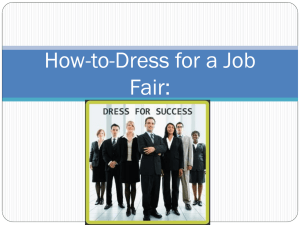WHAT TO WEAR Dressing for Success
advertisement

WHAT TO WEAR Dressing for Success Think about it from the employer's perspective - if you were hiring an intern or professional employee, would you be more impressed with: a student in a business suit or a student dressed in jeans and a t-shirt? The basic rule is to dress one step more professionally than what you would wear on the job. Often, this means you will dress in business professional (a business suit) for career fairs, interviews, and other interactions with employers. Don’t wait until the last minute to acquire interview attire. Your clothing should fit, so you need to allow time for tailoring if necessary. If you’re not used to professional dress, you also need to allow time to “practice” wearing your suit so that you are not uncomfortable during the interview or career fair. Be conservative. It’s always better to be overdressed than underdressed. Think about your field and dress the part. For example, if you are going into a conservative field, such as banking, it’s best to stay as conservative as you can. However, if your field involves more creativity, such as fashion or advertising, it’s okay to stray a bit from the “typical” interview suit and even show your fashion sense. If you aren’t sure what is considered appropriate dress at the company you’re targeting, it’s okay to call Human Resources and ask! Students attending a UNC Charlotte career fair should check the dress code for the event. For candidates seeking full-time, post-graduate jobs or internships and co-ops, business professional (a suit) is expected. Career fairs that have a focus on part-time employment still require business casual. If you’re concerned that you’ll have to buy a whole new wardrobe on a limited budget, don’t be. One or two quality business suits should serve you from your interviews to your first day on the job and even beyond. A few variations in your shirt, tie, or other accessories are simple ways to change your look without leaving you broke. Besides, no one will fault you (or even know!) if you wear the same suit for each interview. Then, once you are earning money and can observe firsthand what is “standard” for your company, you can add on to your wardrobe. Remember, first impressions count significantly and are often formed in a matter of seconds – before you’ve had the opportunity to say a word! What Is Business Professional? Men: business suit with conservative wellpressed dress shirt, and tie (of a muted color) OR slacks, dress shirt, tie, and blazer; dark, mid-calf socks and polished shoes; well-groomed hair and finger nails; avoid cologne, facial hair, body piercings, and visible tattoos Women: business suit (skirt or slacks) with light or pastel colored blouse OR slacks/skirt/dress with blazer; closed toe and heel shoes and sheer panty hose; subtle jewelry, makeup, hairstyle, and nail polish; avoid perfume, revealing or tight clothing, body piercings, and visible tattoos Both: Choose a conservative-colored suit – black, navy, or dark brown. Carry a professional purse, briefcase, or portfolio. Shine up worn shoes with shoe polish, or buy new shoes if you can afford to. What Is Business Casual? The business casual “look” may be a bit different from one workplace to the next. That’s why it’s best to dress conservatively and be too formal rather than take the risk of being underdressed. In general, the following guidelines will satisfy any event requiring business casual attire. Men: slacks, collared shirt, and tie (blazer optional) Women: slacks or skirt with collared shirt (blazer optional) OR professional dress (blazer optional) Both: No jeans, shorts, tennis shoes, or flip flops. Try to leave your backpack behind if you are attending a career fair. As with business professional, avoid anything that puts the employer’s focus (or your own) on what you are wearing instead of what you are saying! Taken from CareerSpots.com – “Interview Tips for Men” and “Interview Tips for Women” and CollegeGrad.com – Dressing for Interview Success 11/15



